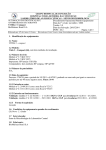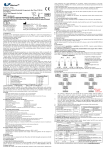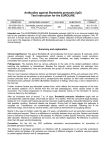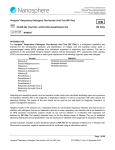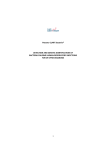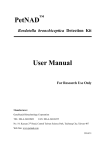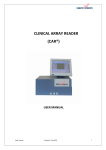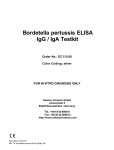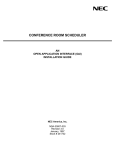Download Bordetella pertussis B parapertussis B - bio
Transcript
IVD For in Vitro Diagnostic Use Bordetella pertussis/B.parapertussis/ B.bronchiseptica Real-TM Handbook Real Time PCR test for detection and differentiation of Bordetella pertussis, Bordetella parapertussis and Bordetella bronchiseptica REF B84-100FRT 100 Sacace™ Bordetella pertussis/B. parapertussis/B. bronchiseptica Real-TM VER 21.03.2013 Sacace™ Bordetella pertussis/B. parapertussis/B. bronchiseptica Real-TM VER 21.03.2013 NAME Bordetella pertussis/B. parapertussis/B. bronchiseptica Real-TM INTRODUCTION Bordetella is a genus of small (0.2 - 0.7 µm), Gram-negativecoccobacilli of the phylum proteobacteria. Three species are human respiratorypathogens (B. pertussis, B. parapertussis and B. bronchiseptica). Bordetella pertussis is an obligate human pathogen and is the causative agent of whooping cough (pertussis). Bordetellaparapertussis causes a milder form of disease in humans and also causes respiratory infections in sheep. Bordetellabronchisepticahas the broadest host range, causing disease in many mammalian species, but kennel cough in dogs and atrophic rhinitis, in which infected piglets develop deformed nasal passages, have the biggest economic impact.Humans,however,arerarelyinfectedwiththisorganism.Wheninfectionsinhumansoccur,theyar eoftenacquiredthroughanimalcontactandtypicallyinvolveimmunocompromised patients.ThespectrumofimmunocompromisedpatientswhohavedevelopedB.bronchiseptica infectionincludespatientswithmalignanciessuchasHodgkin's disease, chroniclymphocytic leukemia, cardiacand bone marrow transplantation patients,patients with AIDS. INTENDED USE Bordetella pertussis/B. parapertussis/B. bronchiseptica Real-TMPCR kit is an in vitro nucleic acid amplification test for detection and differentiation of pathogens that cause whooping cough (Bordetella pertussis), parapertussis (Bordetellaparapertussis), and Bordetellabronchiseptica infection (Bordetellabronchiseptica) in the clinical materials (nasal and oropharyngeal swabs) and culture of microorganisms by using real-time hybridization-fluorescence detection. Sacace™ Bordetella pertussis/B. parapertussis/B. bronchiseptica Real-TM VER 21.03.2013 PRINCIPLE OF ASSAY Bordetella determination by the polymerase chain reaction (PCR) with hybridization fluorescent detection includes three stages: DNA extraction from clinical samples, PCR-amplification of pathogen genome specific region and real-time hybridization fluorescent detection. DNA is extracted from samples in presence of Internal Control (IC), which allows to monitor the analysisof each sample.In real-time PCR, the amplified product is detected using fluorescent dyes. These dyes are linked to oligonucleotide probes which bind specifically to the amplified product during thermocycling. The real-time monitoring of the fluorescence intensities during the real-time PCR allows the detection of PCRproduct without re-opening the reaction tubes after the PCR run. During the amplification stage, four simultaneous reactions take place – amplification of the conservative region of ptxA gene that codes pertussis toxin located in Bordetella pertussis, Bordetella parapertussis and Bordetella bronchiseptica genomes; identification of specific regions in genomes of Bordetella pertussis and Bordetella bronchiseptica as well as amplification of nucleic acid sequence of the Internal Control (IC) sample: Detection channel Result FAM/Green IC detection JOE/HEX/Yellow Detection of pertussis toxin gene, ptxA ROX/Orange Identification of Bordetella pertussis Cy5/Red Identification of Bordetella bronchiseptica In case of pertussis toxin gene detection (JOE/HEX/Yellow channel), the conclusion about presence of Bordetella spp. (B.pertussis, B.parapertussis or B.bronchiseptica) is made. If results are concurrently positiveboth in JOE/HEX/Yellow and ROX/Orange channels, the sample is considered positive for Bordetella pertussis. If results are concurrently positive both inJOE/HEX/Yellow and Cy5/Red channels, the sample is considered positive for Bordetella bronchiseptica. Presence of Bordetella parapertussis can be concluded in case of pertussis toxin gene detection (JOE/HEX/Yellow channel) in the sample negative for Bordetella pertussis and Bordetella bronchiseptica providing that sufficient Bordetella DNA is available. Sacace™ Bordetella pertussis/B. parapertussis/B. bronchiseptica Real-TM VER 21.03.2013 MATERIAL PROVIDED Module No.1: Real Time PCR kit (B84-100FRT) Bordetella pertussis/B. parapertussis/B. bronchiseptica Real-TM: Real Time amplification • PCR-mix-1-FRT Bordetella, 5 x 0.2 ml • PCR-mix-2-FRT, 0.6 ml • TaqF Polymerase, 0.06 ml • Pos Control DNA Bordetella spp.(C+), 2 x 0.1 ml • Positive Control IC, 2 x 0.1 ml • TE-buffer, 2 x 0.5 ml • Negative Control (C-)*, 1.2 ml • Internal Control (IC)**, 2 x 0.6 ml Contains reagents for 100 reactions (including controls). * must be used in the extraction procedure as Negative Control of Extraction. ** add 10 µl of Internal Control during the DNA extraction procedure directly to the sample/lysis mixture. MATERIALS REQUIRED BUT NOT PROVIDED • DNA extraction kit • Disposable powder-free gloves and laboratory coat • Automatic adjustable pipettes (from 5 to 20 µl and from 20 to 200 µl) • Disposable tips with aerosol barriers (100 or 200 µl) in tube racks • Tube racks • Vortex mixer/desktop centrifuge • PCR box • Real Time PCR instrument • Disposable polypropylene microtubes for PCR or PCR-plate • Refrigerator for 2–8 °C, Deep-freezer for ≤ –16 °C Sacace™ Bordetella pertussis/B. parapertussis/B. bronchiseptica Real-TM VER 21.03.2013 STORAGE INSTRUCTIONS All components of theBordetella pertussis/B. parapertussis/B. bronchiseptica Real-TM PCR kit (except for PCR-mix-1-FRT, PCR-mix-2-FRT, and TaqF Polymerase) are to be stored at 2– 8 ºC when not in use. All components of the Bordetella pertussis/B. parapertussis/B. bronchiseptica Real-TM PCR kit are stable until the expiration date on the label. The shelf life of reagents before and after the first use is the same, unless otherwise stated. PCR-mix-1, PCR-mix-2-FRT and TaqF Polymerase are to be stored at ≤ –16ºC. PCR-mix-1is to be kept away from light. STABILITY Bordetella pertussis/B. parapertussis/B. bronchiseptica Real-TM Test is stable up to the expiration date indicated on the kit label. The product will maintain performance through the control date printed on the label. Exposure to light, heat or humidity may affect the shelf life of some of the kit components and should be avoided. Repeated thawing and freezing of these reagents should be avoided, as this may reduce the sensitivity. Components stored under conditions other than thoseonesstated on the labels may not perform properly and may adversely affect the assay results. QUALITY CONTROL In accordance with Sacace’s ISO 13485-Certified Quality Management System, each lot is tested against predetermined specifications to ensure consistent product quality. Sacace™ Bordetella pertussis/B. parapertussis/B. bronchiseptica Real-TM VER 21.03.2013 WARNINGS AND PRECAUTIONS In Vitro Diagnostic Medical Device For In Vitro Diagnostic Use Only The user should always pay attention to the following: • Use sterile pipette tips with aerosol barriers and use new tip for every procedure. • Store extracted positive material (samples, controls and amplicons) away from all other reagents and add it to the reaction mix in a separate area. • Thaw all components thoroughly at room temperature before starting an assay. • When thawed, mix the components and centrifuge briefly. • Use disposable gloves, laboratory coats and eye protection when handling specimens and reagents. Thoroughly wash hands afterwards. • Do not eat, drink, smoke, apply cosmetics, or handle contact lenses in laboratory work areas. • Do not use a kit after its expiration date. • Dispose of all specimens and unused reagents in accordance with local authorities’ regulations. • Specimens should be considered potentially infectious and handled in a biological cabinet in accordance with appropriate biosafety practices. • Clean and disinfect all sample or reagent spills using a disinfectant such as 0.5% sodium hypochlorite, or other suitable disinfectant. • Avoid sample or reagent contact with the skin, eyes, and mucous membranes. If skin, eyes, or mucous membranes come into contact, rinse immediately with water and seek medical advice immediately. • Material Safety Data Sheets (MSDS) are available on request. • Use of this product should be limited to personnel trained in the techniques of DNA amplification. • The laboratory process must be one-directional, it should begin in the Extraction Area and then move to the Amplification and Detection Areas. Do not return samples, equipment and reagents to the area in which the previous step was performed. Some components of this kit contain sodium azide as a preservative. Do not use metal tubing for reagent transfer. Sacace™ Bordetella pertussis/B. parapertussis/B. bronchiseptica Real-TM VER 21.03.2013 PRODUCT USE LIMITATIONS All reagents may exclusively be used in in vitro diagnostics. Use of this product should be limited to personnel trained in the techniques of DNA amplification (EN375). Strict compliance with the user manual is required for optimal PCR results. Attention should be paid to expiration dates printed on the box and labels of all components. Do not use a kit after its expiration date. SAMPLE COLLECTION AND TRANSPORT Bordetella pertussis/B. parapertussis/B. bronchiseptica Real-TM PCR kitis intended for the analysis ofDNA extracted from: Posterior nasopharynx swabs. Throat swabs and anterior nasal swabs have unacceptably low rates of DNA recovery and should not be used for pertussis diagnosis. The swab tips may be polyester (such as Dacron®), rayon, or nylon-flocked. Cotton-tipped or calcium alginate swabs are not acceptable as residues present in these materials inhibit PCR assays. When the material is obtained, place the working part of the swab in a sterile disposable tube with 500 µl of transport medium for storage and transportation of respiratory swabs. Break off the terminal part of the probe to allow tight closing of the tube cup. Close the tube with the solution and the working part of the probe, and mark it. Oropharyngeal swabs are taken with a probe with a dry viscose swab. Take swabs by rotating the probe over the surface of tonsils, palatine arches, and the posterior wall of the pharynx. When the material is obtained, place the working part of the swab in a sterile disposable tube with 500 µl of transport medium for storage and transportation of respiratory swabs. Break off the terminal part of the probe to allow tight closing of the tube cap. Close the tube with the solution and the working part of the probe, and mark it. Storage of clinical specimens is allowed for 3 days at 2–8 °С or during a week at ≤ –16 °C. Microorganism cultures are resuspended in 1 ml of 0,9 % saline or 0,01 Мphosphate buffer, pH 7,0. The obtained suspension is used for subsequent DNA extraction. Transportation of clinical specimens must comply with country, federal, state and local regulations for the transport of etiologic agents. DNA ISOLATION The following kits are recommended: DNA/RNA Prep(Sacace, REF K-2-9) Ribo-Sorb(Sacace, REF K-2-1) Please carry out DNA extraction according to the manufacture’s instruction. DNA is extracted from each clinical sample in the presence of Internal Control (10µl of IC is added to each sample). Transfer 100µl of Negative Control to the tube labeled C–. Sacace™ Bordetella pertussis/B. parapertussis/B. bronchiseptica Real-TM VER 21.03.2013 PCR PROTOCOL 1. Prepare the required number of tubes for amplification of DNA from clinical and control samples. Thaw the tubes with PCR-mix-1-FRTBordetella. VortexPCR-mix-1- FRTBordetella,PCR-mix-2-FRT, polymerase (TaqF) and centrifuge briefly (1-2 sec). 2. Prepare the required number of tubes or strips (including controls) for DNA amplification. 3. For N reactions, add to a new tube: − 10*(N+1) µl ofPCR-mix-1-FRTBordetella, − 5.0*(N+1) µl of PCR-mix-2-FRT, − 0.5*(N+1) µl ofTaqF polymerase. When calculating the volume of the reaction mixture, take into account controls (negative control of extraction, positive and negative controls of amplification). Refer to Table 1 for calculated reaction volumes: Table 1. Reaction mixture preparation scheme Volume of reagents for indicated number of reactions 10,00 5,00 0,50 Reagent volume for one reaction (µl) Number of samples (N) to be analyzed* 2 PCR-mix-1FRTBordetella, µl 60 4 80 40 4,0 6 100 50 5,0 8 120 60 6,0 10 140 70 7,0 12 160 80 8,0 14 180 90 9,0 16 200 100 10,0 PCR-mix-2-FRT, µl TaqF Polymerase, µl 30 3,0 *Number of samples including DNA extraction and amplification controls (N+4). 4. Mix the tube with the prepared mixture and vortex it briefly. 5. Transfer 15 µl of the prepared mixture to prepared tubes. 6. Add 10 µl of DNA obtained after nucleic acid extraction from clinical or control samples. 7. Carry out the control amplification reactions: NCA - Add 10 µl of TE-buffer to the tube labeled NCA (Negative control of amplification). C+ - Add 10 µl of Positive Control DNA Bordetella spp. to the tube labeled C+(Positive control of amplification). IC+ - Add 10 µl of Positive Control ICto the tube labeled CS+ (Positive control of IC amplification). C- - Add 10 µl of a sample extracted from the Negative Control to the tube labeled C- (Negative Control of Extraction). Sacace™ Bordetella pertussis/B. parapertussis/B. bronchiseptica Real-TM VER 21.03.2013 It is recommended to sediment drops from walls of tubes by short vortex (1–3 s) before inserting them in the thermalcycler. Amplification 1. Create a temperature profile on your instrument as follows: Rotor-type instruments1 Step Temperature, °С 1 2 95 95 60 72 95 3 60 72 Plate-type instruments2 Time Cycles Temperature, °С Time Cycles 15 min 10 s 20 s 10 s 10 s 20 s Fluorescence detection 10 s 1 35 60 15 min 10 s 25 s 25 s 10 s 30s Fluorescence detection 25 s 1 10 95 95 60 72 95 72 10 35 1 For example Rotor-Gene™ 3000/6000/Q (Corbett Research, Qiagen) 2 For example, iQ5™ (BioRad); Mx3005P™ (Agilent), ABI® 7500 (Applied), SmartCycler® (Cepheid), SaCycler96™(Sacace) Fluorescent signal is detected in FAM/Green, JOE/Yellow/HEX, ROX/Orange, and Cy5/Red channels. 2. Place PCR tubes into the PCR instrument. 3. Run amplification and signal detection program. 4. After measurement, start data analysis and interpretation of results. INSTRUMENT SETTINGS Rotor-type instruments(RotorGene 6000/Q) Threshold Calibrate / Gain Optimisation… More Settings/ Outlier Removal Slope Correct FAM/Green 0.1 from 5Fl to 10Fl 0% Off JOE/Yellow 0.1 from 5Fl to 10Fl 5% Off Rox/Orange 0.1 from 5Fl to 10Fl 5% Off Cy5/Red 0.1 from 5Fl to 10Fl 5% Off Channel Plate- or modular type instruments (SaCycler, iQ5, Mx300P, ABI 7500, SmartCycler) For result analysis, set the threshold line at a level corresponding to 10–20% of the maximum fluorescence signal obtained for Pos C+ sample during the last amplification cycle. Sacace™ Bordetella pertussis/B. parapertussis/B. bronchiseptica Real-TM VER 21.03.2013 DATA ANALYSIS The results are analyzed by the software oftheused real-time PCR Instrument. Interpretation of the results is performed by the crossing (or not) of the fluorescence curve with the adjusted threshold line for each single fluorescent channel employed. It defines presence (or absence) of threshold cycle (Ct) for a certain DNA sample in the according graph of the resultant table. Principle of interpretation of results: PCR curves of accumulatedfluorescent signal are analyzed in four channels: Detection channel Result FAM/Green JOE/HEX/Yellow ROX/Orange Cy5/Red Detection of Identification Identification of pertussis toxin of Bordetella Bordetella gene, ptxA pertussis bronchiseptica IC detection – in the JOE/HEX/Yellow channel, signal indicating amplification of pertussis toxin gene fragment present in genomes of Bordetella pertussis, Bordetella parapertussis and Bordetella bronchiseptica is registered; – in the ROX/Orangechannel, signal indicating amplification of genome’s specific region of Bordetella pertussis is registered; – in the Cy5/Red channel, signal indicating amplification of genome’s specific region of Bordetella bronchiseptica is registered; – in the FAM/Green channel, signal indicating amplification of Internal Controlis registered. The result of amplification is considered to be positive if the real-time PCR fluorescent curve is typically S-shaped, crosses threshold line in the area of reliable increment of fluorescence, and Ct value in the results grid for a particular channel is less than the indicated boundary value, negative – in case of absence of typically S-shaped curve not crossing the threshold line (does not have Ct), or Ct exceeds the indicated boundary value. The results of analysis are considered reliable only if the results obtained for positive and negative controls of amplification and negative control of extraction are correct (see Table 2). Table 2. Results for controls Value of threshold cycle, Сt Control Stage for control FAM/Green IC JOE/HEX/ Yellow Pertussis toxin gene, ptxA ROX/Orange Cy5/Red Bordetella pertussis Bordetella bronchiseptica NCE DNA extraction <30 Neg Neg Neg NCA Amplification Neg Neg Neg Neg IC+ Amplification <27 Neg Neg Neg C+ Amplification Neg <25 <27 <26 Sacace™ Bordetella pertussis/B. parapertussis/B. bronchiseptica Real-TM VER 21.03.2013 Principle of interpretation of results: Interpretation of results of PCR analysis for detection and differentiation of pathogens that cause whooping cough (Bordetella pertussis), parapertussis(Bordetellaparapertussis), and Bordetellabronchisepticainfection (Bordetellabronchiseptica) is based on amplification results in accordance with Table 3. Table 3. Interpretation of results for PCR-analysis FAM/Green Variants JOE/HEX/ Yellow ROX/ Orange Cy5/Red Interpretation Value of threshold cycle, Сt 1 2 3 4 5 absentor absentor >29 >25 <29 ≤35 or absent absent Invalid absent absent absent B.pertussis B.parapertussis B.bronchiseptica NOT detected ≤35 ≤35 absent B.pertussis DNA detected ≤35 absent ≤35 B.bronchiseptica DNA detected <25 absent absent B.parapertussis DNA detected absent ≤35 or absent ≤35 or absent 6 <29 >25 absent absent 7 <29 absent ≤35 absent 8 <29 absent absent ≤35 Bordetella spp. DNA detected: B.pertussis, or B.parapertussis, or B.bronchiseptica. For differentiation, repeat sampling and extraction. If the result is repeated in PCR, interpret as equivocal If the result is repeated in PCR, interpret as equivocal − Bordetella pertussis, Bordetellaparapertussis and Bordetellabronchiseptica is not detected in a sampleif the Ct value of a sample specified in the table for the HEX,ROX andCy5 channels has not been detected (absent), i.e. the PCR florescent curve does not cross the threshold line. Herewith, Ct value for internal control (IC) (FAM) does not exceed 29. − Bordetellapertussis DNA is detected in a sample if the Ct value of a sample specified in the table for theHEX and ROX channelsis less or equal to 35, and the PCR fluorescent curve should have typical exponential increase of fluorescent signal. In such samples, Ct for internal control (IC) (FAM) can have any value or be absent in case of high pathogen load in a sample. Sacace™ Bordetella pertussis/B. parapertussis/B. bronchiseptica Real-TM VER 21.03.2013 − B. bronchiseptica DNA is detected in a sample if the Ct value of a sample specified in the table for the HEX and Cy5channels is less or equal to 35, and the PCR fluorescent curve should have typical exponential increase of fluorescent signal. In such samples, Ct for internal control (IC) (FAM) can have any value or be absent in case of high pathogen load in a sample. − B. parapertussis DNA is detected in a sample if the Ct value of a sample specified in the table for the HEX channel does not exceed 25, and Ct values for the ROX and Cy5 channels are absent. In such samples, Ct for internal control (IC) (FAM) can have any value or be absent in case of high pathogen load in a sample. − Bordetella spp. (B. pertussis, or B. parapertussis, or B. bronchiseptica) DNA is detected if Ct value of a sample specified in the table for the JOE/Yellow channel exceed 25, Ct values for the ROX and Cy5 channels are absent, Ct for internal control (IC) (FAM) does not exceed 29. That can take place if the quantity of extracted DNA is insufficient. For species differentiation, repeat sampling and nucleic acid extraction steps. − Results should be interpreted as equivocal if a repeated PCR analysis demonstrates absent Ct value in the HEX channel, while Ct values in the ROX (or Cy5) and FAM channels do not exceed 29. Repeat of sampling is advised. − Results should be interpreted as invalid if the Ct values of a sample specified in the table for the ROX and Cy5 channels have not been detected (absent), for the HEX channel – is absent or exceed 25, and for internal control (IC) (FAM) - is either absent or exceed 29. In this case, repeat nucleic acid extraction step for the required clinical sample. Results of analysis are not taken into account in the following cases: − If Ct value of positive control DNA Bordetella spp. (C+) in the appropriate channel is absent or exceeds boundary value (see Table 3), repeat amplification for all negative clinical samples. − The samples with negative result in all channels should be analyzed once more starting from the nucleic acid extraction stage. If negative result is obtained in the second run, repeat collection of the clinical material. Negative result is normally detected only for the Negative Control of amplification (NCA). − If the Ct value for the Positive Control of amplification (C+) is absent or exceeds the boundary Ct value in the appropriate channel, repeat amplification for all negative clinical samples. − If the Ct value is present for the Negative Control of extraction (C–) and/or Negative Control of amplification (NCA) in the channel for detection of any gene target (HEX,ROX andCy5), repeat the analysis for all samples in which the specific gene was detected starting from the nucleic acid extraction stage to rule out possible contamination. Sacace™ Bordetella pertussis/B. parapertussis/B. bronchiseptica Real-TM VER 21.03.2013 SPECIFICATIONS Sensitivity The analytical sensitivity of Bordetella multiplex Real-TMPCR kit for the stated causative agents is no less than 5х102copies per 1 ml of sample. Specificity Bordetella multiplex Real-TMPCR kit makes it possible to detect DNA specific regions of the statedcausative agents. The specificity of this kit was confirmed by investigation of the following reference strains: Streptococcusspp., Moraxella catarrhalis, Staphilococcus aureus, Staphilococcus saprophiticus, Haemophilus influenzae, Proteus mirabilis, Klebsiella pneumoniae, Pseudomonas aeruginosa, Mycobacteria tuberculosis 27294 105, Neisseria flava, Neisseria sicca, Neisseria mucosa, E. coli ATCC, NCTC, 01577 27u7, Enterococcus faecalis, Mycoplasma pneumoniae, Chlamydophila pneumoniae, Legionella pneumophila, Shigella flexneri, Shigella sonnei, Salmonella Enteritidis, Yersinia enterocollitica – as well as human genomic DNA. TROUBLESHOOTING Results of analysis are not taken into account in the following cases: 1. If Ct value of positive control DNA Bordetella spp. (C+) in the appropriate channel is absent or exceeds boundary value, amplification stage is to be repeated for all clinical samples interpreted as negative. 2. If Ct value of negative control of extraction (C-) in the JOE/HEX/Yellow,ROX/Orange andCy5/Red channels and/or negative control of amplification (NCA) in any fluorescent channel is detected, test analysis must be repeated from the extraction stage and measures to detect and eliminate the source of possible contamination must be taken. 3. If a positive result (the fluorescence curve crosses the threshold line) is detected for a sample that has a fluorescence curve without the typical exponential growth phase (the curve is linear), this may suggest incorrect setting of the threshold line or incorrect calculation of baseline parameters. Such a result should not be considered as positive. If you have any further questions or if you encounter problems, please contact our Authorized representative in the European Community. Sacace™ Bordetella pertussis/B. parapertussis/B. bronchiseptica Real-TM VER 21.03.2013 Sacace™ Bordetella pertussis/B. parapertussis/B. bronchiseptica Real-TM VER 21.03.2013 KEY TO SYMBOLS USED List Number Caution! Contains sufficient Lot Number for <n> tests For in Vitro Diagnostic Use Version Store at NCA Negative Control of Amplification Manufacturer NCE Negative control of Extraction C+ Positive Control of Amplification IC Internal Control Consult instructions for use Expiration Date * SaCycler™ is a registered trademark of Sacace Biotechnologies * CFX™ and iQ5™ are trademarks of Bio-Rad Laboratories * Rotor-Gene™ is a registered trademark of Qiagen *MX3005P® are trademarks of Agilent Technologies *ABI® is trademarks of Applied Biosystems * SmartCycler® is a registered trademark of Cepheid Sacace Biotechnologies Srl via Scalabrini, 44 – 22100 –Como – Italy Tel +390314892927 Fax +390314892926 mail: [email protected] web: www.sacace.com Sacace™ Bordetella pertussis/B. parapertussis/B. bronchiseptica Real-TM VER 21.03.2013
















